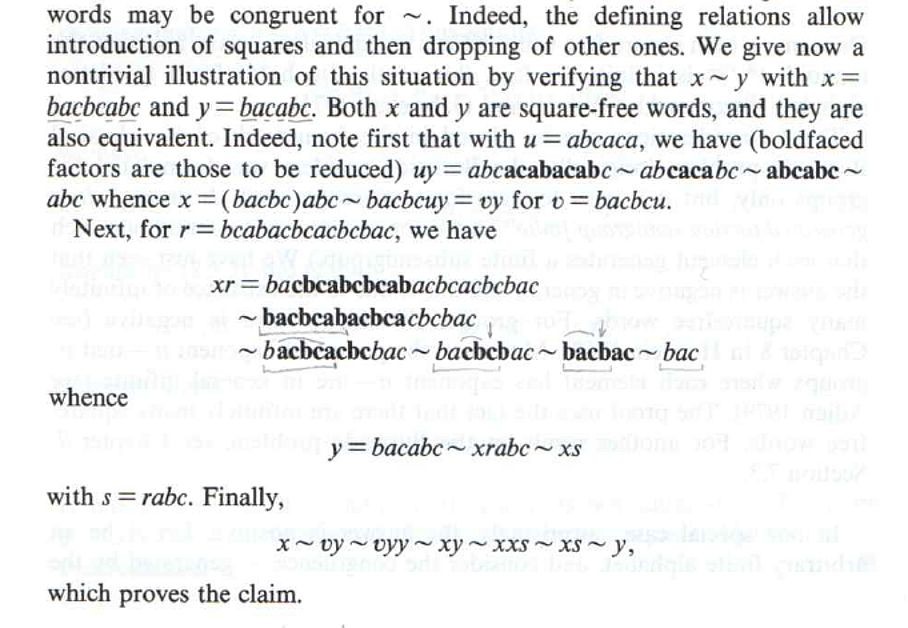Free Idempotent Rigs and Monoids
Posted by John Baez
I’ve been having a lot of fun on Mathstodon lately, and here’s an example.
A rig has a commutative associative addition, an associative multiplication that distributes over addition, an element with and for all , and an element with for all .
A rig is idempotent if for all .
Is the free idempotent rig on generators finite? If so, how many elements does it have?
Morgan Rogers raised this issue on the Category Theory Community server, and after a bit of progress I posed this as a puzzle on Mathstodon. By now three people there have independently figured out the answer.
I’ll let you think about the free idempotent rig on 1 generator.
The free idempotent rig on 2 generators, say and , has at most elements. To see this, first consider the free idempotent monoid on 2 generators, say . This is the free monoid on 2 generators modulo relations saying that everything squared is itself. This has 7 elements:
Starting from this we can form the free idempotent rig on and by taking linear combinations. But notice that in an idempotent rig we have
or , for short. We thus get , , etc. So, these are all the elements we get by repeatedly adding :
Just 4 elements! It follows that when we start adding any element of the free idempotent rig on 2 generators to itself, we get at most 4 different elements:
Since has 7 elements, it follows that the free idempotent rig on 2 generators has at most elements.
But in fact it has far fewer, because there are a lot of other relations. For example we have
because both sides equal . More surprisingly, MathCuddler discovered that
because
but also
so they’re equal.
Nonetheless, 3 people on Mastodon have worked through the maze of relations with the help of a computer: Alex Gunning, Greg Egan and Simon Frankau.
They all concluded that the free idempotent rig on 2 generators has 284 elements!
You can see a list of the elements on Simon’s github, along with his code, and another list of the elements on Alex’s github. On his github, Greg Egan has posted a list of the elements together with all ways of writing each element as a linear combination of the 7 elements of
The next question: how many elements does the free idempotent rig on generators have?
This is more interesting. When I said the free idempotent monoid on generators has 7 elements, you may have just looked at this:
and accepted it, because these are clearly all the 7 ‘square-free words’ on two letters. A square-free word is one that don’t contain a nonempty repeated subword. For example is a square-free word on letters, while is not.
But something more interesting happens for the free idempotent monoid generators. When , there are infinitely many square-free words on letters, and yet the the free idempotent monoid on generators is still finite!
I don’t actually understand this. I would guess that a rewrite rule like to remove repeated subwords would be terminating and confluent and thus allow us to reduce any element of the free idempotent monoid on letters to a ‘normal form’ which is a square-free word. If this were true, I think the free idempotent monoid on generators would be infinite — because there are infinitely many square-free words on letters. So it seems this algorithm cannot actually be confluent! But I haven’t found a case of non-confluence. Can you help straighten me out here?
Anyway, the fact that the free idempotent monoid on n generators is finite implies the same for the free idempotent rig on n generators. For example, the Online Encyclopedia of Integer Sequences assures us that the free idempotent monoid on 3 generators has 160 elements. Given this, the free idempotent rig on 3 generators must have elements, by the same argument I gave for 2 generators. But in fact it should have far fewer.
Is anyone brave enough to compute the number?


Re: Free Idempotent Rigs and Monoids
Math Stackexchange gives a reference that — if it’s correct— should prove the rewrite rule I described is nonconfluent:
Apparently this reference proves that
in the free commutative monoid on 3 generators, even though both sides are square-free words, so there is no way to further reduce them using the rewrite rule BB B.